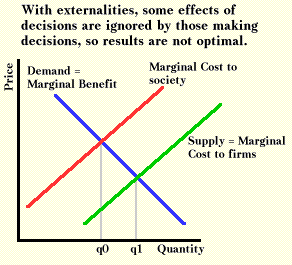Externalities and Efficiency
The second problem when resources are "free" is that the wrong mix of goods and services will be produced. (In terms of efficiency, the marginal rate of transformation will not equal the marginal rate of substitution.) This is a common result when decision-makers do not take into account some by-product of their actions that burdens or benefits others. A polluter, for example, considers air or water free. For him, dumping pollutants into the air or water is a cheap way to dispose of wastes, but that is because he does not worry that he has caused others to forego clean air or water.
It is easy to show that when a decision-maker ignores some costs of his decision, his decision may be economically inefficient. The graph below assumes that the market can be represented by supply and demand curves. The demand curve represents the marginal benefit to consumers (and to firms because they are price takers). The supply curve represents the marginal cost to sellers, and because producing the product requires resources that could be used elsewhere, it also represents a cost to buyers. But the production of the product also generates an unwanted by-product that sellers ignore. The marginal cost from the point of view of society as a whole includes this by-product and is thus higher than it seems to the firm. The economically efficient amount to produce in this illustration is q0, but the forces of the market will tend to result in the production of q1.

If negative externalities cause too much of a product to be produced, positive externalities should cause too little to be produced. When a person improves his house, his neighbors benefit. If the decision-maker does not consider these spillover advantages to others, less than the efficient amount of the activity will take place. In terms of a supply-and-demand diagram, the marginal benefit curve as perceived by the decision-maker will be to the left of the marginal benefit curve of society as a whole, and thus too little of the activity will take place.
When scarce resources are perceived as "free", there will be potential value that a market will not capture. Is it possible for a society to capture this value, and if so, how?
A common "solution" to this problem has been to assume it away. This solution is especially common in plans for utopias, and writers in the Marxian tradition frequently illustrate it. In some of these arguments, pollution exists because capitalistic man is greedy, but when the new socialist man comes into existence, the problem will cease. Solution by assumption has at times crept into mainstream economic thinking as well.
A more practical solution is to increase private ownership in the system of property rights.1 This is an ironic solution in a way, because many environmentalists and ecologists have argued that the existence of externalities proves that a market system is seriously flawed and should be scrapped for an alternative, generally with greater state ownership and control. Economic analysis, however, shows that externalities exist when property rights are incomplete. Reducing the role of private property would make the externality problem worse. When no one owns the air or water, there is no incentive to avoid an overuse of the resource.
In a classic example of the problem of the commons, buffalo were hunted almost to extinction in the 19th century. If an individual hunter limited his kills, he was unlikely to benefit from his restraint. Someone else would probably kill a buffalo that he did not kill. Yet, from the point of view of buffalo hunters as a group, the optimal strategy would have been to limit killing so that the industry could maintain itself indefinitely.
In contrast with the buffalo, the number of cattle in the American West increased during the 19th century. The key difference between the different fates of buffalo and cattle was not that buffalo hunters were greedy and cattle raisers were not. It was that cattle were privately owned and buffalo were "free." Private-property rights force people to take into account all costs and benefits of their actions. A cattleman's decision to kill or not kill his cattle did not affect other cattlemen in the way that a buffalo hunter's decision to kill or not kill buffalo affected other buffalo hunters. When a resource is owned by all, when it is "free," there is a strong tendency for individuals to misuse that resource.
However, economist Ronald Coase recognized that there was no system of private property rights that could yield economically efficient results if transactions costs were too great.
1Every society has a system of property rights. Property rights are the social rules, that may or may not be legally enforced, that tell people where they can be and what they are allowed to do with locations and physical objects. Economics stresses that some systems of property rights lead to more economically efficient results than others.
Copyright Robert Schenk